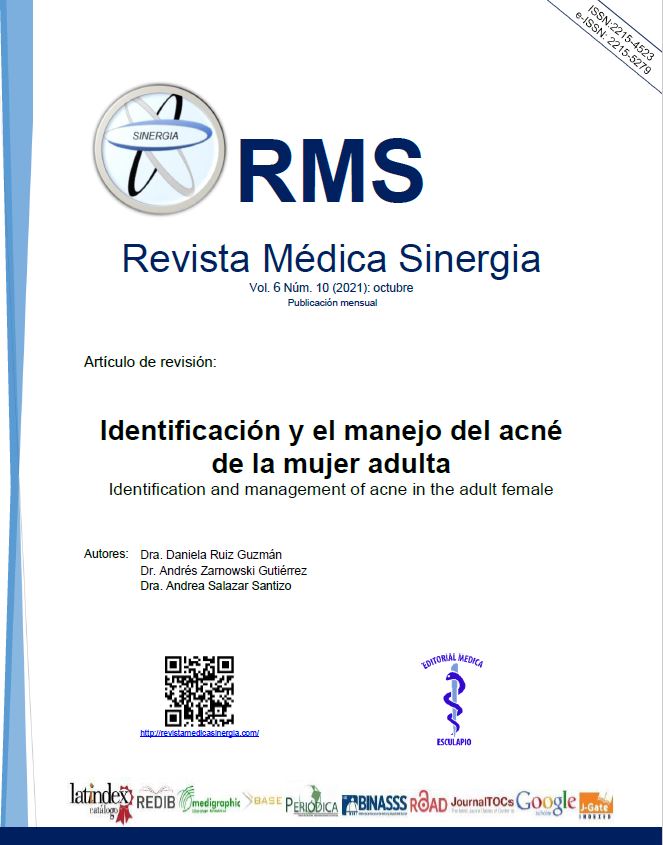Abstract
Acne is a very common skin condition, however, in most cases once adolescence is over, it disappears as the patient's hormones are regulated. When acne persists or begins after adolescence, it is known as adult acne, it occurs in most cases in females, that is why it is known as Adult Female Acne.
Acne in patients over 25 years of age causes social stigmatization and deterioration in the quality of life of the patient, hence they come for consultation. In medical practice, it is frequently observed how patients ask for help to eliminate their acne and consequently, both the general practitioner and the Dermatologist must identify the pathology and know the proper management according to the latest guidelines recommended both nationally and internationally.
The objective of this publication is to provide the most recent guidelines and the necessary tools to the primary care general practitioner to be able to identify adult female acne and decide on an appropriate management according to their abilities and also help them make the right decision of the ideal moment to refer the patient to a dermatologist to be medicated and managed with the best regimen for their pathology.
The management of adult female acne will be based on a topical treatment, which is commonly known as skincare, and systemic treatments which will depend on the severity and extent of the acneiform lesions. The systemic therapeutic options vary from antibiotics, oral contraceptives, isotretinoin, antiandrogens, among others. The decision on the management to be prescribed should be individualized for each patient according to their needs, background, conditions, and expectations.
Keywords
References
Fabbrocini G, Capasso C, Donnarumma M, Cantelli M, Le Maître M, Monfrecola G, et al. A peel-off facial mask comprising myoinositol and trehalose-loaded liposomes improves adult female acne by reducing local hyperandrogenism and activating autophagy. J Cosmet Dermatol. 2017;16(4):480–4.
Bolognia JL, Schaffer JV, Cerroni L, editores. Dermatolog a. 4a ed. Elsevier; 2018.
Isvy-Joubert A, Nguyen J-M, Gaultier A, Saint-Jean M, Le Moigne M, Boisrobert E, et al. Adult female acne treated with spironolactone: a retrospective data review of 70 cases. Eur J Dermatol. 2017;27(4):393–8.
Bagatin E, Freitas THP de, Rivitti-Machado MC, Machado MCR, Ribeiro BM, Nunes S, et al. Adult female acne: a guide to clinical practice. An Bras Dermatol. 2019;94(1):62–75.
Di Landro A, Cazzaniga S, Cusano F, Bonci A, Carla C, Musumeci ML, et al. Adult female acne and associated risk factors: Results of a multicenter case-control study in Italy. J Am Acad Dermatol. 2016;75(6):1134-1141.e1.
Poli F, Auffret N, Claudel JP, Leccia M-T, Dreno B. AFAST: an adult female acne treatment algorithm for daily clinical practice. Eur J Dermatol. 2018;28(1):101–3.
Anaba EL, Oaku IR. Adult female acne: A cross-sectional study of diet, family history, body mass index, and premenstrual flare as risk factors and contributors to severity. Int J Womens Dermatol. 2021;7(3):265–9.
Falla T, Rodan K, Fields K, Ong D, Skobowiat C. Safety and efficacy of a novel three-step anti-acne regimen formulated specifically for women. Int J Womens Dermatol. 2020;6(5):419–23.
Patiyasikunt M, Chancheewa B, Asawanonda P, Noppakun N, Kumtornrut C. Efficacy and tolerability of low-dose spironolactone and topical benzoyl peroxide in adult female acne: A randomized, double-blind, placebo-controlled trial. J Dermatol. 2020;47(12):1411–6.
Trivedi MK, Shinkai K, Murase JE. A Review of hormone-based therapies to treat adult acne vulgaris in women. Int J Womens Dermatol. 2017;3(1):44–52.
Bansal P, Sardana K, Arora P, Khurana A, Garga UC, Sharma L. A prospective study of anti-mullerian hormone and other ovarian and adrenal hormones in adult female acne. Dermatol Ther. 2020;33(6):e13974.
Franik G, Bizoń A, Włoch S, Kowalczyk K, Biernacka-Bartnik A, Madej P. Hormonal and metabolic aspects of acne vulgaris in women with polycystic ovary syndrome. Eur Rev Med Pharmacol Sci. 2018;22(14):4411–8.
Tan AU, Schlosser BJ, Paller AS. A review of diagnosis and treatment of acne in adult female patients. Int J Womens Dermatol. 2018;4(2):56–71.
Chottawornsak N, Chongpison Y, Asawanonda P, Kumtornrut C. Topical 2% ketoconazole cream monotherapy significantly improves adult female acne: A double-blind, randomized placebo-controlled trial. J Dermatol. 2019;46(12):1184–9.
Vargas-Mora P, Morgado-Carrasco D. Uso de la espironolactona en dermatología: acné, hidradenitis supurativa, alopecia femenina e hirsutismo. Actas Dermosifiliogr. 2020;111(8):639–49.
Barker RA, Wilcox C, Layton AM. Oral spironolactone for acne vulgaris in adult females: An update of the literature. Am J Clin Dermatol. 2020;21(2):303–5.
Garg V, Choi JK, James WD, Barbieri JS. Long-term use of spironolactone for acne in women: A case series of 403 patients. J Am Acad Dermatol. 2021;84(5):1348–55.

This work is licensed under a Creative Commons Attribution-NonCommercial 4.0 International License.
Copyright (c) 2021 Array


